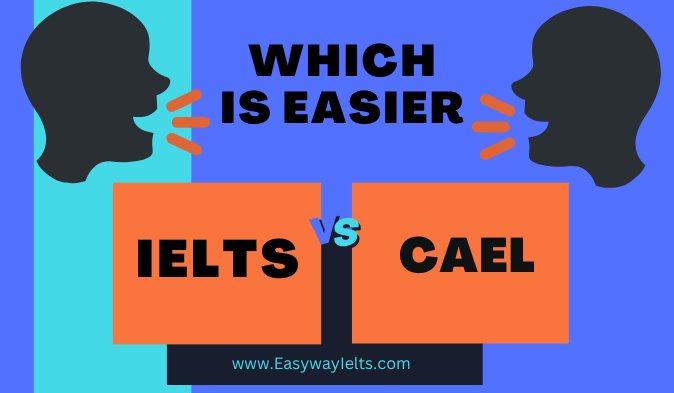“Which is easier Ielts or Cael?” – a query that sparks curiosity and beckons for clarity.
In this article, we delve into the nuances of Canadian study English language testing, shedding light on the CAEL vs. IELTS debate.
Brace yourself for insights, comparisons, and most importantly, free practice resources to empower your preparation journey!
What is CAEL?
The Canadian Academic English Language (CAEL) Assessment is a language proficiency test designed to assess the English language abilities of students planning to study at Canadian universities or colleges.
Test Format
CAEL provides scores on a scale from 10 to 90, averaging the four section scores.
Widely accepted by Canadian educational institutions, CAEL’s focus on academic English prepares students for the language demands of higher education, making it a preferred choice for those seeking admission to Canadian universities and colleges.
It measures the four key language skills: reading, writing, listening, and speaking. The test is fully computer-delivered and consists of three main parts:
- Listening
- Reading
- Writing
In the speaking section, test takers engage in a one-on-one interview with a qualified examiner, which is recorded and later assessed.
Scoring System
The scoring system of the Canadian Academic English Language (CAEL) Assessment employs a band scale ranging from 10 to 90, with each of the four sections—listening, reading, writing, and speaking—being scored individually.
Test takers receive a score for each section, and their overall score is calculated as an average of these four individual scores. This overall score is then rounded to the nearest whole number.
This system allows for a detailed assessment of a candidate’s proficiency in each language skill area, providing institutions with a comprehensive view of the test taker’s English language abilities for academic pursuits in Canadian universities or colleges.
Here’s an example to illustrate the scoring system of the Canadian Academic English Language (CAEL) Assessment:
Let’s say a student takes the CAEL test and receives the following scores for each section:
- Listening: 80
- Reading: 75
- Writing: 85
- Speaking: 70
To calculate the overall CAEL score, we would add up the scores for each section:
80 (Listening) + 75 (Reading) + 85 (Writing) + 70 (Speaking) = 310
Then, we divide this total by the number of sections (4) to get the average score:
310 (total) / 4 (sections) = 77.5
Finally, we round this average score to the nearest whole number:
77.5 rounds to 78
So, in this example, the student’s overall CAEL score would be 78.
This score provides a clear snapshot of the student’s English language proficiency across the listening, reading, writing, and speaking sections of the test, aiding Canadian universities or colleges in assessing the student’s readiness for academic studies.
Purpose & Applicability
CAEL is widely accepted by Canadian universities and colleges as proof of English language proficiency for admission purposes.
It is particularly popular because of its focus on academic contexts and tasks, preparing students for the language demands they will face in their studies.
The purpose and applicability of the Canadian Academic English Language (CAEL) Assessment lie in its wide acceptance among Canadian universities and colleges as a trusted measure of English language proficiency for admission purposes.
CAEL is particularly valued for its emphasis on academic contexts and tasks, aligning closely with the language demands that students will encounter in their studies at Canadian educational institutions.
By requiring students to demonstrate proficiency in reading, writing, listening, and speaking within an academic framework, CAEL ensures that test takers are well-equipped to succeed in their university or college endeavors.
This focus on academic English not only helps institutions assess the readiness of applicants but also aids students in acclimating to the language expectations and challenges they will encounter in their Canadian academic journey.
As a result, CAEL serves as a valuable tool for both institutions and students, facilitating smoother transitions into higher education and ensuring a strong foundation in academic English skills.
What is IELTS?
The International English Language Testing System (IELTS) stands as a globally recognized benchmark for assessing the English language proficiency of individuals seeking to study, work, or immigrate in English-speaking environments.
With its comprehensive test format, IELTS evaluates candidates across four essential language skills: Listening, Reading, Writing, and Speaking.
Recognized by thousands of institutions worldwide, including universities, employers, immigration authorities, and professional bodies, IELTS serves as a trusted measure of an individual’s ability to effectively communicate in English.
By offering both Academic and General Training versions, IELTS caters to diverse needs, whether it be pursuing higher education in an English-speaking country or embarking on a career path that requires strong English language skills.
Let’s delve into the details of each section to understand the format, tasks, and scoring of this esteemed language proficiency assessment.
Test Format
The International English Language Testing System (IELTS) is a globally recognized language proficiency test.
It assesses the language ability of candidates who need to study or work where English is the language of communication.
IELTS also tests the four language skills: listening, reading, writing, and speaking.
Listening Section
Format – The Listening section lasts for around 30 minutes. It includes four recorded monologues and conversations. The recordings cover various contexts, such as social situations, academic discussions, and everyday conversations.
Tasks – Test takers are required to listen attentively and answer a series of questions based on the recordings. They may need to fill in blanks, answer multiple-choice questions, or label diagrams or maps.
Reading Section
Format – The Reading section is 60 minutes long. It consists of three reading passages, each with increasing difficulty. The passages are taken from books, journals, magazines, and newspapers.
Tasks – Test takers must answer questions that assess their ability to understand main ideas, locate specific information, and comprehend the writer’s opinion or argument. Questions may include multiple-choice, matching, True/False/Not Given, or sentence completion.
Writing Section
Format – The Writing section spans 60 minutes and is divided into two tasks.
Task 1 (150 words) – In the Academic version, test takers must describe visual information like graphs, charts, or diagrams. In the General Training version, they write a letter based on a given situation.
Task 2 (250 words) – Test takers write an essay in response to a point of view, argument, or problem. They are expected to present a coherent and well-structured argument.
Speaking Section
Format – The Speaking section is a face-to-face interview with a certified examiner. It is divided into three parts and typically takes around 11-14 minutes.
Part 1 – Introduction and general questions about familiar topics such as hobbies, work, studies, etc.
Part 2 – Test takers are given a cue card with a topic. They have one minute to prepare and then speak for up to two minutes on the topic.
Part 3 – Follow-up questions related to Part 2, discussing more abstract ideas and issues.
Scoring System
The scoring system of the International English Language Testing System (IELTS) uses a nine-band scale to evaluate the proficiency of test takers in English.
Each band on this scale corresponds to a specific level of competence in the language, ranging from band 1 (Non-User) to band 9 (Expert User).
When a candidate takes the IELTS test, they receive individual scores for each of the four sections: Listening, Reading, Writing, and Speaking.
These section scores are reported as whole or half band scores (e.g. 6.5, 7.0, 7.5). Also, an overall band score is provided, which is the average of the four section scores. This overall band score is rounded to the nearest half or whole band.
For instance, if a candidate scores 7.5 in Listening, 7.0 in Reading, 6.5 in Writing, and 7.0 in Speaking, their overall band score would be the average of these scores, which is 7.0.
The band scale provides a clear and standardized way to assess a candidate’s English language proficiency across different skills, aiding universities, employers, immigration authorities, and other institutions in making informed decisions about an individual’s language abilities.
Purpose
The International English Language Testing System (IELTS) serves distinct purposes depending on the version taken, whether it is the IELTS Academic or IELTS General Training.
IELTS Academic
- Purpose – The IELTS Academic version is primarily designed for individuals who are planning to pursue higher education or professional registration in English-speaking countries.
- University Admissions – Many universities and colleges in English-speaking countries require IELTS Academic scores as part of their admissions process. The test assesses a candidate’s readiness to undertake academic study in English by evaluating their ability to comprehend and use complex academic language.
- Professional Registration – Some professional organizations and bodies also require IELTS Academic scores as proof of English language proficiency for certain fields such as medicine, nursing, engineering, and more.
- Content Focus – The test tasks are oriented towards academic contexts, with reading passages from academic journals, listening excerpts from lectures and discussions, and writing tasks that include summarizing data or arguing a point of view on academic topics.
IELTS General Training
- Purpose – The IELTS General Training version is typically required for individuals who are planning to migrate to an English-speaking country for purposes other than higher education.
- Migration and Work – Many countries, such as Canada, Australia, the UK, and New Zealand, use IELTS General Training scores as part of their immigration requirements. This version assesses a candidate’s ability to communicate effectively in common social and workplace situations.
- Secondary Education – In some cases, individuals seeking to enroll in secondary education programs in English-speaking countries may also be required to take the IELTS General Training test.
- Content Focus – The test tasks are designed to simulate everyday situations, such as reading notices, advertisements, or workplace-related documents; listening to conversations and discussions; writing letters or essays on general topics; and engaging in a conversation with a certified examiner on everyday themes.
In essence, the IELTS Academic version is tailored to assess a candidate’s readiness for academic study at the university or college level in an English-speaking environment.
On the other hand, the IELTS General Training version focuses on evaluating practical English language skills necessary for migration, work, or secondary education in English-speaking countries.
The distinction between the two versions ensures that individuals demonstrate their proficiency in English relevant to their specific goals and destinations, providing a standardized measure of language ability for a wide range of purposes.
Conclusion
In this guide, we have explored the question “Is CAEL Easier than IELTS?” and provided insights to help you make an informed decision on which test is the right fit for you.
We compared the formats, difficulty levels, scoring systems, and factors to consider such as study goals, strengths, weaknesses, and university requirements.
It is important to note that the difficulty of CAEL versus IELTS vary based on your individual skills and preferences.
To recap, CAEL offers a specialized focus on academic English, particularly for those aiming to study in Canadian universities or colleges.
Its computer-delivered format, academic-oriented tasks, and scoring system make it a valuable choice for students preparing for the demands of higher education.
On the other hand, IELTS provides versatility with its Academic and General Training versions, catering to various study, work, or immigration goals.
It assesses a range of language skills in diverse contexts, offering a globally recognized benchmark for English proficiency.
Selecting the right English language test is crucial for your academic or career success. Consider your study goals, strengths, weaknesses, test availability, costs, and the specific requirements of the institutions you are applying to.
By choosing the test that aligns with your skills and objectives, you can confidently showcase your English language proficiency to universities, employers, or immigration authorities.
Now that you have a clearer understanding of CAEL and IELTS, it’s time to start your practice journey.
Prepare effectively for your chosen test by accessing free practice materials, taking sample tests, and familiarizing yourself with the test format and tasks.
This will not only build your confidence but also enhance your chances of success on test day. Begin your preparation today and pave the way for English language testing success!
Remember, the key to success lies in thorough preparation and choosing the test that best reflects your abilities and aspirations.
Start your practice journey now and prepare for your English language test with confidence!
Good luck!
Frequently Asked Questions (FAQs)
- Is CAEL better than IELTS?
The choice between CAEL and IELTS depends on individual preferences and study goals. CAEL is tailored for Canadian academic contexts, while IELTS offers versatility for various purposes worldwide.
- Which is easier than IELTS?
Some may find IELTS General Training easier than IELTS Academic due to its focus on everyday language and scenarios.
- What is the maximum score for CAEL test?
The maximum score for the CAEL test is 90, with scores reported on a band scale from 10 to 90.
- Is IELTS or Cambridge easier?
The difficulty level varies for individuals, but generally, IELTS and Cambridge English exams are both reputable assessments with different focuses. Some may find one easier based on their strengths.
- Is IELTS the hardest exam?
IELTS is considered challenging but not necessarily the hardest. Other exams like the TOEFL or Cambridge C2 Proficiency may also be seen as challenging depending on individual strengths.
- Which is the easiest English test?
The easiest English test can vary for each individual. Some may find exams like the Cambridge A2 Key or IELTS 5.0-5.5 easier due to their lower proficiency level requirements.
- Which IELTS is the hardest?
For many, the IELTS Academic test is considered more challenging due to its focus on academic language, complex texts, and detailed analysis compared to the General Training version.



